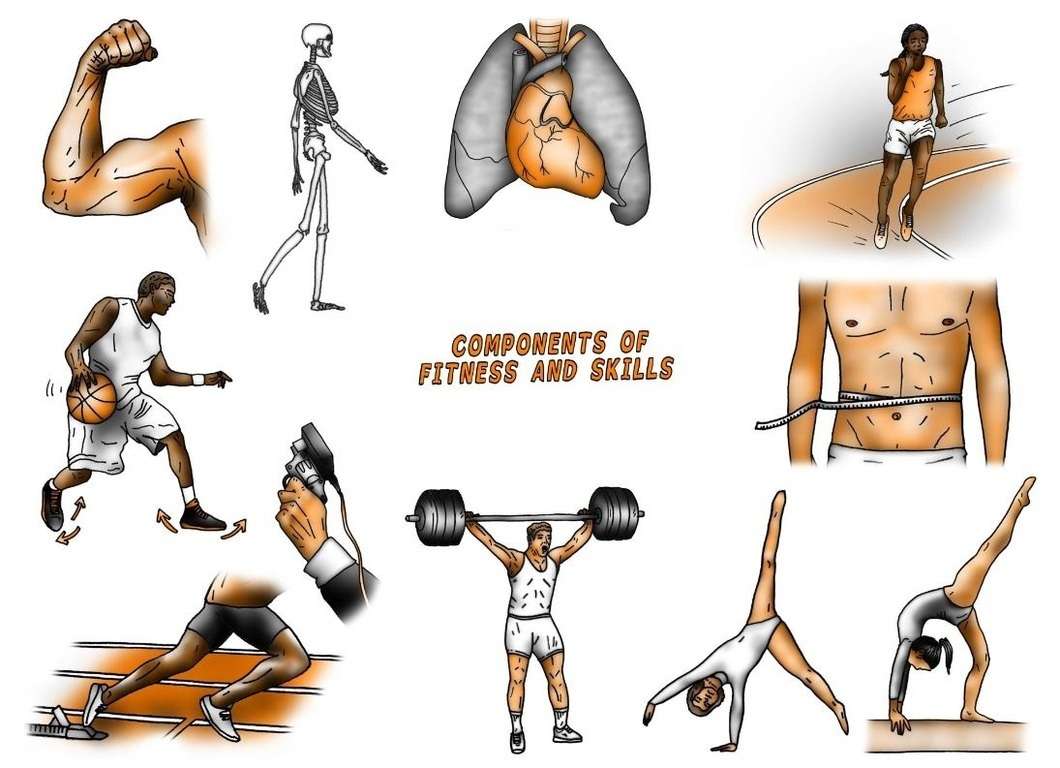Understanding the Fitness Components
Running is an activity that requires a balanced combination of various fitness components. These components include cardiovascular endurance, muscular strength, muscular endurance, flexibility, body composition, and agility. Each of these elements plays a crucial role in enhancing running performance and overall fitness level.
Cardiovascular endurance, in particular, is the primary fitness component for running. It refers to the ability of the heart, lungs, and blood vessels to supply oxygen and nutrients to the working muscles during sustained physical activity. A strong cardiovascular system enables runners to maintain a steady pace for longer distances, recover more quickly between intervals, and reduce the risk of injury.
Muscular strength is another essential fitness component for running. Strong muscles, especially in the lower body, can generate more force with each stride, leading to faster running speeds and improved endurance. Muscular endurance, on the other hand, is the ability of the muscles to sustain repeated contractions over an extended period. This component is crucial for maintaining a consistent pace during long-distance runs.
Flexibility is also vital for runners, as it allows for a full range of motion in the joints and reduces the risk of injury. A flexible body can also help improve running form and efficiency, allowing for a smoother, more fluid stride. Body composition, or the ratio of body fat to lean muscle mass, is another critical factor in running performance. A healthy body composition can improve running economy, reduce injury risk, and enhance overall fitness level.
Lastly, agility is the ability to change direction quickly and efficiently while maintaining control and balance. While not as crucial for straight-line running as other fitness components, agility can still play a role in trail running, obstacle courses, and other running activities that require quick movements and changes in direction.
Cardiovascular Endurance: The Key Fitness Component for Running
Cardiovascular endurance is the most critical fitness component for running, as it directly impacts a runner’s ability to sustain effort over time. This component is particularly important for long-distance running and sprinting, as it enables runners to maintain a steady pace and reduce fatigue.
Cardiovascular endurance is closely related to the body’s ability to supply oxygen and nutrients to the working muscles during sustained physical activity. When the heart, lungs, and blood vessels are functioning optimally, they can deliver more oxygen and nutrients to the muscles, allowing them to work harder and longer. As a result, runners with strong cardiovascular endurance can maintain a faster pace for longer distances and recover more quickly between intervals.
Improving cardiovascular endurance can also lead to overall fitness level improvements. Runners with strong cardiovascular endurance are less likely to experience injuries, as their bodies are better equipped to handle the physical demands of running. Additionally, cardiovascular endurance can have positive effects on mental health, reducing stress and anxiety and improving mood and cognitive function.
To improve cardiovascular endurance for running, there are several methods and exercises to consider. Interval training, which involves alternating between high-intensity and low-intensity exercise, can be particularly effective. Tempo runs, which involve running at a challenging but sustainable pace for an extended period, can also help improve cardiovascular endurance. Additionally, long-distance running, such as marathon or half-marathon training, can significantly enhance cardiovascular endurance over time.
When incorporating these exercises into a running routine, it’s essential to start slowly and gradually increase the intensity and duration of each workout. This approach can help prevent injury and ensure that the body is adequately prepared for the physical demands of each exercise. Additionally, it’s important to allow for adequate recovery time between workouts, as this can help prevent fatigue and improve overall performance.
Improving Cardiovascular Endurance for Running
Cardiovascular endurance is the ability of the heart, lungs, and blood vessels to supply oxygen and nutrients to the working muscles during sustained physical activity. For runners, improving cardiovascular endurance can significantly enhance running performance and overall fitness level. Here are some methods and exercises to consider:
- Interval training: This involves alternating between high-intensity and low-intensity exercise. For example, a runner might sprint for 30 seconds, followed by a 1-minute jog. Interval training can be particularly effective for improving cardiovascular endurance, as it challenges the body to work harder and recover more quickly.
- Tempo runs: These involve running at a challenging but sustainable pace for an extended period. A tempo run might last for 20-30 minutes, with the runner maintaining a pace that is approximately 25-30 seconds slower per mile than their 10K race pace. Tempo runs can help improve cardiovascular endurance by teaching the body to sustain a challenging pace over time.
- Long-distance running: Running for extended periods, such as during marathon or half-marathon training, can significantly enhance cardiovascular endurance. Long-distance running challenges the body to sustain a steady pace for an extended period, which can lead to improvements in endurance and overall fitness level.
When incorporating these exercises into a running routine, it’s essential to start slowly and gradually increase the intensity and duration of each workout. This approach can help prevent injury and ensure that the body is adequately prepared for the physical demands of each exercise. Additionally, it’s important to allow for adequate recovery time between workouts, as this can help prevent fatigue and improve overall performance.
To further enhance cardiovascular endurance, runners might also consider incorporating cross-training activities, such as swimming or cycling, into their routine. These activities can provide a welcome break from running while still challenging the cardiovascular system. Additionally, strength training, particularly in the core and lower body, can help improve running form and efficiency, leading to further improvements in cardiovascular endurance.
Additional Fitness Components Supporting Running Performance
While cardiovascular endurance is the most critical fitness component for running, other components, such as muscular strength, muscular endurance, and flexibility, can also contribute to improved running performance. Here’s how:
- Muscular strength: Strong muscles, particularly in the legs, can help improve running speed and efficiency. Exercises such as squats, lunges, and deadlifts can help build muscular strength in the lower body. Resistance training, such as using free weights or resistance bands, can also be effective.
- Muscular endurance: This refers to the ability of the muscles to sustain repeated contractions over an extended period. Building muscular endurance can help improve running stamina and reduce fatigue. Exercises such as step-ups, burpees, and mountain climbers can help build muscular endurance in the lower body.
- Flexibility: A flexible body can help improve running form and reduce the risk of injury. Stretching exercises, such as dynamic stretches before a run and static stretches after a run, can help improve flexibility. Yoga and Pilates can also be effective for improving flexibility and core strength.
To develop these fitness components, it’s essential to incorporate a variety of exercises and activities into a running routine. For example, a runner might perform strength training exercises twice a week, incorporate dynamic stretches before each run, and practice yoga or Pilates once a week. Additionally, cross-training activities, such as swimming or cycling, can provide a welcome break from running while still challenging the body in different ways.
It’s important to note that building fitness components takes time and consistency. Runners should aim to progress gradually, increasing the intensity and duration of each workout over time. Additionally, it’s essential to allow for adequate recovery time between workouts, as this can help prevent injury and improve overall performance.
Assessing Your Fitness Level for Running
Before starting a running program or modifying an existing one, it’s essential to assess your current fitness level. This can help you create a personalized running plan that targets specific fitness components and sets realistic goals. Here are some methods for assessing your fitness level:
- VO2 max testing: This measures the maximum amount of oxygen your body can use during exercise. A higher VO2 max indicates a higher level of cardiovascular fitness. VO2 max testing can be done in a lab or with a wearable device that estimates VO2 max based on heart rate and speed.
- The Cooper test: This is a 12-minute run test that measures the distance covered in that time. The distance can be used to estimate VO2 max and aerobic fitness level. To perform the Cooper test, find a track or a flat, measured path and run as far as possible in 12 minutes.
- The 1.5-mile run test: This measures the time it takes to run 1.5 miles. The result can be used to estimate VO2 max and aerobic fitness level. To perform the 1.5-mile run test, find a track or a flat, measured path and time yourself while running 1.5 miles as fast as possible.
Once you have assessed your fitness level, it’s essential to interpret the results and use them to create a personalized running plan. For example, if your VO2 max is low, you might focus on improving cardiovascular endurance through interval training and long-distance running. If your muscular strength is weak, you might incorporate strength training exercises into your routine. It’s important to set realistic goals based on your current fitness level and progress gradually over time.
Regularly reassessing your fitness level can help you track progress and adjust your running plan as needed. This can help you maintain continuous improvement and prevent plateaus in your running performance.
Creating a Running Plan to Improve Fitness Components
Once you have assessed your fitness level, it’s time to create a running plan that targets specific fitness components and sets realistic goals. Here’s how:
- Setting goals: Start by setting specific, measurable, and achievable goals. For example, you might aim to run a 5K race in under 30 minutes or improve your VO2 max by 5%. Make sure your goals are aligned with your current fitness level and progress gradually over time.
- Determining training frequency and duration: Decide how many days a week you will run and how long each run will be. Aim for a balance between challenging yourself and avoiding overtraining. For example, if you are a beginner, you might start with three 20-minute runs per week and gradually increase the duration and frequency as your fitness level improves.
- Incorporating cross-training activities: Incorporating cross-training activities, such as strength training, yoga, or swimming, can help improve overall fitness level and prevent injuries. Aim to incorporate one or two cross-training activities per week, depending on your schedule and preferences.
- Progression and periodization: Progression and periodization are essential for continuous improvement. Progression refers to gradually increasing the intensity and duration of each workout over time. Periodization involves varying the intensity and volume of training throughout the year to avoid plateaus and prevent overtraining. For example, you might follow a periodization plan that includes base-building, peaking, and tapering phases.
It’s important to remember that creating a running plan is a personalized process. What works for one person might not work for another. Listen to your body, be patient, and make adjustments as needed. With consistency, dedication, and a well-designed running plan, you can improve your fitness level and achieve your running goals.
Maintaining Motivation and Consistency in Running
Running can be a challenging and rewarding pursuit, but it requires consistency and motivation to see progress. Here are some strategies for staying motivated and consistent in your running routine:
- Setting achievable goals: Setting specific, measurable, and achievable goals can help you stay motivated and focused. For example, you might aim to run a certain distance or time, or complete a certain number of runs per week. Make sure your goals are aligned with your current fitness level and progress gradually over time.
- Tracking progress: Tracking your progress can help you see how far you’ve come and motivate you to keep going. Consider using a running app or a fitness tracker to monitor your runs, track your distance and pace, and set personal bests. Celebrate your achievements, no matter how small, and use them as motivation to keep improving.
- Joining a running group: Running with others can be a great way to stay motivated and accountable. Consider joining a local running group or finding a running partner who shares your goals and interests. Running with others can also be a fun and social way to stay active and meet new people.
- Mixing it up: Doing the same runs every week can get boring and lead to burnout. Mix up your routine by trying new routes, changing your pace, or incorporating different types of runs, such as intervals, hills, or tempo runs. This can help keep your running routine interesting and challenging.
- Viewing running as a lifelong pursuit: Running is a lifelong pursuit that can provide numerous health and wellness benefits. Rather than viewing it as a means to an end, try to embrace the journey and enjoy the process. Focus on the positive aspects of running, such as the sense of accomplishment, the stress relief, and the opportunity to connect with nature and your surroundings.
Remember, consistency is key when it comes to running. Even if you have a bad run or miss a few days, don’t get discouraged. Instead, focus on getting back on track and maintaining a consistent routine. With patience, dedication, and a positive attitude, you can achieve your running goals and maintain a healthy and active lifestyle.
Continuously Evaluating and Adjusting Your Running Plan
Regularly evaluating and adjusting your running plan is crucial for maintaining progress and preventing plateaus. Here are some tips for continuously improving your running performance:
- Tracking progress: Regularly tracking your progress can help you identify areas for improvement and adjust your running plan accordingly. Consider using a running app or a fitness tracker to monitor your runs, track your distance and pace, and set personal bests. Celebrate your achievements, no matter how small, and use them as motivation to keep improving.
- Reassessing fitness level: Periodically reassessing your fitness level can help you determine whether your running plan is effective and whether any adjustments are necessary. Consider retaking the Cooper test or the 1.5-mile run test every few months to monitor your progress and adjust your running plan as needed.
- Setting new goals: Setting new goals can help you stay motivated and challenged. Consider setting a new distance or time goal, or incorporating new types of runs, such as intervals or hills, into your routine. Make sure your goals are specific, measurable, and achievable, and adjust your running plan accordingly.
- Incorporating cross-training activities: Incorporating cross-training activities, such as strength training, yoga, or swimming, can help improve overall fitness level and prevent injuries. Aim to incorporate one or two cross-training activities per week, depending on your schedule and preferences. Make sure to adjust your running plan to account for any additional time or energy spent on cross-training activities.
- Listening to your body: Listening to your body is essential for preventing injuries and maintaining progress. If you feel pain, fatigue, or burnout, consider taking a break or adjusting your running plan. Make sure to get enough rest and recovery time, and adjust your running plan as needed to accommodate any changes in your fitness level or schedule.
Remember, a running plan is not set in stone. It should be flexible and adaptable to your changing needs and goals. By regularly evaluating and adjusting your running plan, you can maintain continuous improvement and prevent plateaus. With patience, dedication, and a positive attitude, you can achieve your running goals and maintain a healthy and active lifestyle.






